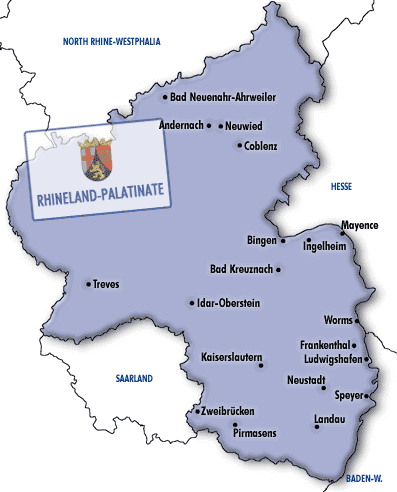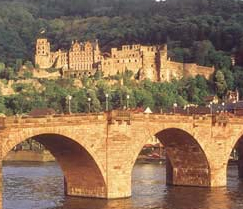
PFALZ NOT BAVARIA

|

|
Unfortunately, nothing about the Pfalz (Palatinate in English) is simple. From the time the territory was created in the Middle Ages, it was never a coherent area. The major segments were the Oberpfalz (upper Pfalz), which is now northern Bavaria, and the Pfalz or Niederpfalz or Rheinpfalz or Kurpfalz (or any of many other names) along the Rhine River. The Pfalz included Heidelberg (capital for several centuries) with some surrounding territory and disconnected fragments on the right bank of the river, and a much larger territory with many fragments on the left bank. The latter was by no means all of what we now call the Pfalz. A traveler could in a good day (30 km or 20 miles) pass through two, three or even four different sovereignties - each the turf of some count, duke, elector, bishop, or the council of a free city. Boundaries wandered with marriages and divorces and external events. The sovereigns were all in theory under the jurisdiction of the Holy Roman Emperor, but as the centuries passed that meant less and less. After 1620 it really meant nothing.
The Pfalz (the political entity) at times had a personal ruler, once had a ruler who was also Holy Roman Emperor, at other times had rulers who were counts or dukes or kings of something else also. But that a person might be sovereign of several bits of territory often did not mean the various bits were given a common administration. The title for the chief Palatine was count, then elector, then for a bit duke.
In 1618, Frederick was the Elector Palatine. Europe was in general ferment on the religious (or church of Rome) question. Czechy (Bohemia to some) had for centuries had an elective monarchy, and for a few turns had elected a Habsburg. In 1618 the very Protestant Czechs decided that they did not want another Catholic king to replace the Habsburg who had just died. They elected the protestant Elector Palatine to the Czech throne. The Habsburgs, being the most powerful family in Europe, did not take kindly to this and sent in the army. The Czechs lost the Battle of White Mountain, Frederick became known as the "Winter King," and a Habsburg and the Catholic church were imposed on Czechy (now the Czech Republic).

|
That small event (to those outside Czechy) touched off a conflagration that involved the Austrian Habsburgs leading a shifting coalition of mostly the Catholic princes of southern Germany against the Lutheran princes of the north. A side line in the west was the continuing war between the Spanish Habsburgs and the United Provinces (Netherlands). In the final decades both Sweden and France were major players on the Protestant side. The action took place in Germany (and the Netherlands), more often armies wasting the landscape than meeting each other in real battles. When the blood stopped flowing 30 years later, with millions dead (2/3 and more of the population in substantial parts of Germany including the Pfalz), peace was finally declared. Nobody actually won the war, but all the big players were compensated for participating. Bavaria was one of the winners, being awarded the Oberpfalz which it had conquered in 1628. It was absorbed into the Bavarian state. The rest of the Pfalz went its own way.
Yet war along the Rhine did not stop. Louis XIV's troops destroyed and pillaged for another 50 years. Landau was awarded to France in 1648, and turned into a garrison fortress. Worms was nearly destroyed in the War of Pfalz Succession 1688 - 97. Speyer outside the cathedral was basically leveled in 1689, and the cathedral "accidentally" set on fire. The castle in Heidelberg was badly damaged in the same year and further in 1693. (Much of what you see is later "romantic" reconstruction.)
In 1742, the Karl Theodor became Elector Palatine. In 1777 he inherited Bavaria. While he was the chief of state of both Bavaria and the Pfalz, they were not administratively combined. So far as I can tell, the only Pfalz records you will find in Bavaria are those concerning official state activities. Nothing for the genealogist.
1798 marked the beginning of a whole new structure. Napoleon redrew the map of much of Germany. The masses of tiny territories in the west were melded into reasonably sized units. The Pfalz on the left bank of the Rhine was annexed to France. At the end of the Napoleonic era, the redrawn sections of the Rheinpfalz were united under the King of Bavaria. Again, it was treated as a separate administrative area. That remained the case until Hitler redrew the map eliminating Bavaria and creating several new "states." (The Rheinpfalz became part of Saarpfalz and after 1940 part of Westmark.) The map was redrawn again after WW2, based to some extent on allied areas of occupation. The left bank Pfalz now constitutes about the southern third of the Land Rheinland-Pfalz, having been combined under French occupation with a piece of Prussia and a bit of Hesse. The right bank Pfalz is part of Land Baden-Württemberg, with some bits in Land Hesse. And the Oberpfalz remains part of Freistaat Bayern.
Under Napoleon, a formal system of citizen records was started. Gemeinde (communes) were to keep complete records of the population. Churches were ordered to turn their people records over to the communes.
Unfortunately for the genealogist, and unlike in the Netherlands, many of the older records were turned back to churches after 1815. Others went to the central Protestant and Catholic archives in Speyer. No attempt was made to collect people records at the provincial or kingdom (of Bavaria) level. WW2 resulted in more destruction. Today it is hard to predict where you should look for a record from before 1800: if it exists, it could be at the commune, the kreis, a common archive created by several gemeinde and/or kreis, the Land Archive in Speyer, a church, or one of the two church archives in Speyer.
So - if you run across an entry with a location of Pfalz, Bavaria, Germany - don't rush off to Munich to do research. You may be barking up the wrong keg. Check carefully what the entry really means, and delete the word "Bavaria" if the location is in the Rhine area. Then plan your trip to Speyer.
For more on the history and geography of the Pfalz, and particularly the maps from 1789, go to Fred Krebs' excellent web site.
24 June 2001